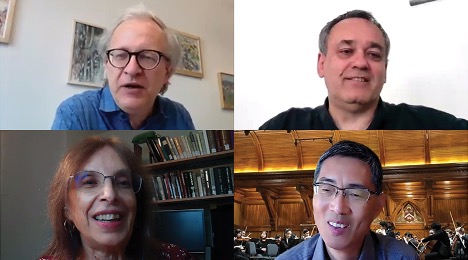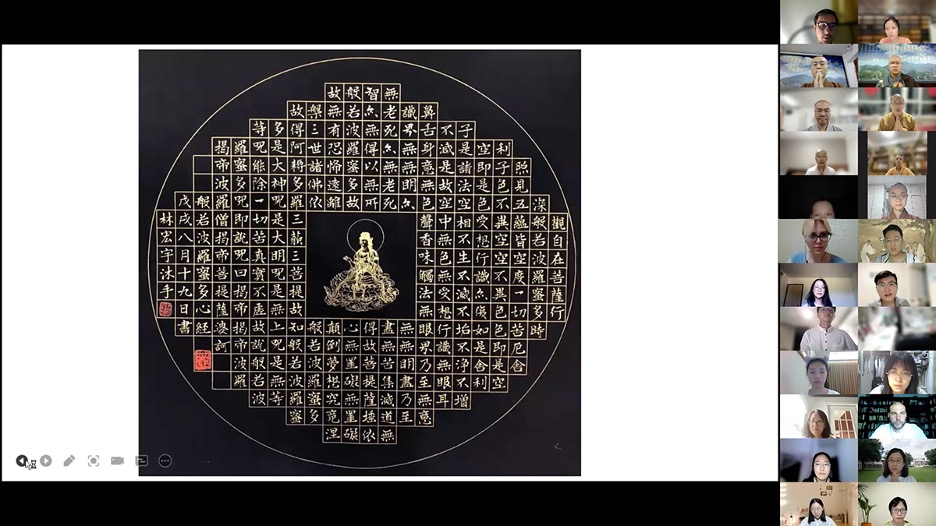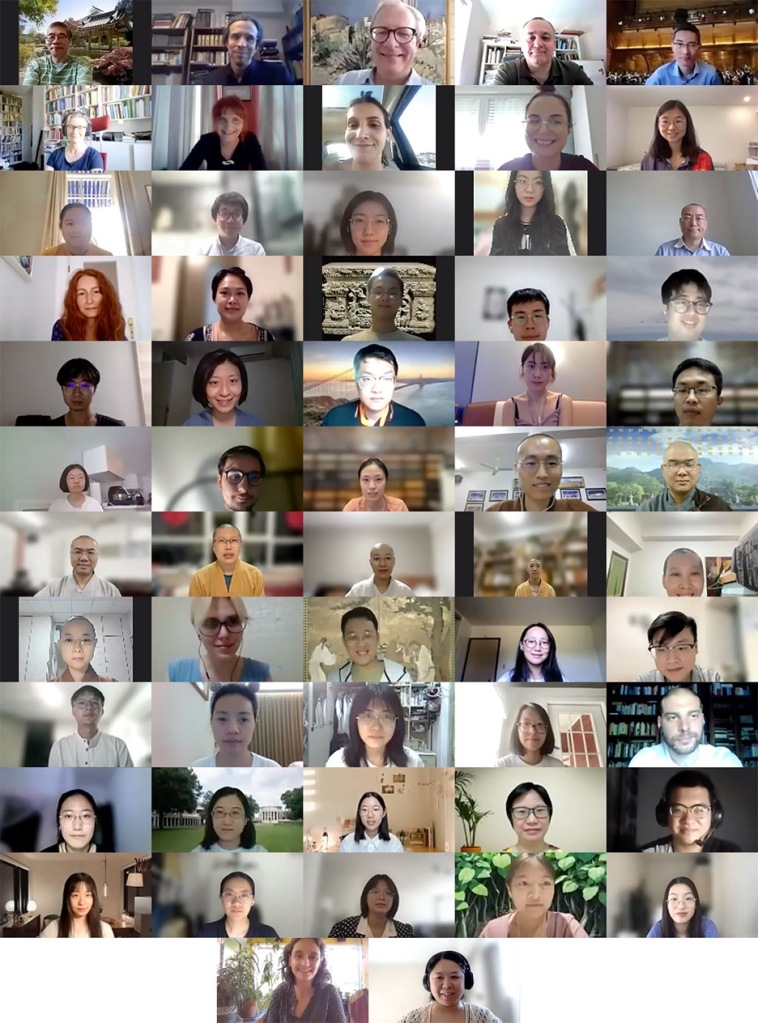Return to the main program page.
2022 Glorisun Intensive Program on Buddhism Report
By Huizhi Wang
University of British Columbia
The 2022 Glorisun International and Intensive Program on Buddhism, co-organized by the Glorisun Network for Buddhist Studies at UBC and Yale University, was held successfully on Zoom from July 20 to August 9, 2022. The three-week program incorporated various events: five seminars and several lectures taught by top scholars of Buddhism studies all over the world; a three-day conference under the topic “How Zen Became Chan”; online tea time with both instructors and other students; and a student forum that provided an opportunity for students to present their works. These activities covered a wide range of topics about East Asian Buddhism, which greatly enlarged and deepened the participants’ understanding on this field.
Opening
The program started with a warm welcome given by Professor Jinhua Chen (University of British Columbia) and Professor Eric Greene (Yale University) on July 20. After that, students with diverse backgrounds briefly introduced themselves, which gave everyone their first opportunity to meet each other and create a close online community for the following three weeks.

Jinhua Chen (left) and Eric Greene (right). Screenshots courtesy of Carol Lee (UBC Frogbear). Republished with permission.
Seminars
The main body of the program consisted of five seminars given respectively by Professor Barend ter Haar (University of Hamburg), Professor Imre Galambos (University of Cambridge), Professor Jacqueline Stone (Princeton University), Professor Eric Greene, and Professor Eugene Wang (Harvard University). Each professor taught five 1.5-hour sessions on a topic related to East Asian Buddhist studies. Focusing on different perspectives, the professors provided us with a feast of knowledge of and methods for studying Buddhism.

Top row: Barend ter Haar and Imre Galambos. Bottom row: Jacqueline Stone and Eugene Wang. Screenshots courtesy of Carol Lee (UBC Frogbear). Republished with permission.
Seminar 1: Barend ter Haar: “Thinking Through Socio-religious Change from the Han to the Late Imperial Period”
In the first session, to ease students into this topic smoothly, Prof. ter Haar began with the basic yet significant problem of terminology in the study of Chinese religious life. This reminded us to stay alert to the implications behind each term and notice the differences between the original texts and their translation. In the following sessions, Prof. ter Haar introduced the socio-religious changes in Chinese society in a chronological timeline from the Shang dynasty to the Qing dynasty. Significant changes happened during such a long timespan. One that appeared early is the rise of anthropomorphic worship. Later, local communities exerted deep influences in the development of religions, forming the basic social religious structure in the late imperial period.
Seminar 2: Imre Galambos: “The Afterlife of Manuscripts in Buddhist Cultures of East and Central Asia”
Through five excellent sessions, Prof. Galambos brought us into the world of manuscript studies. In the beginning session, we learned that manuscripts are not simply carriers of text, they are also objects with physical forms and can be used in non-textual ways. Prof. Galambos showed us different visual images of Buddhist manuscripts to illustrate the various forms of Buddhist manuscripts. Then, he introduced the recycling theory, which includes questions such as how the manuscripts were recycled, the pragmatic reasons for recycling, et cetera. The last few sessions were about the afterlives of manuscripts after they were produced, including the lineages, how they were used as objects in ritual spaces, and how new scrolls were created from old fragments. Through hands-on training in manuscripts reading, students not only became familiar with the manuscripts and the information they included, but also learned new methods that they could apply in their future studies.
Seminar 3: Jacqueline Stone: “The Tendai Buddhist Tradition and Lotus Sūtra Interpretation in Heian and Medieval Japan”
With a turn to Japanese Buddhist studies, Prof. Stone led us into the world of Tendai Buddhist tradition in Japan. In the first session, she gave us an introduction to Tiantai doctrinal foundations, including Tiantai’s practice requirements, its interpretation of the cosmos, its origin, and some of its core ideas. The second session focused on early Japanese Tendai, starting from its establishment in Japan to the esoteric turn it took as it developed. During this process, the Lotus Sūtrawas refigured as the principle of Tendai esoteric teaching. Sessions three and four were about the development of Tendai in medieval Japan. Students were introduced to Tendai’s “original enlightenment” doctrine and the discussions around it. The last session touched upon Tendai’s broader influence on later times and the new directions Buddhism took as a result of its influence. Prof. Stone assigned reading tasks before every session and used breakout rooms to let students discuss their understandings of the readings. With this more involved way of learning, students were able to be more devoted to the classes and had a deeper understanding of the class materials.
Seminar 4: Eric Greene: “From chan to Chan: the Theory and Practice of Buddhist Meditation in Early Medieval China”
In this seminar, Prof. Greene gave us a wide-ranging introduction on chan and Chan Buddhism in the medieval period. The first session was about the Chinese understanding of Buddhist meditation in the Han and Three-Kingdoms period, from which we learned about the reception of meditation in early Chinese history. The second and third sessions focused on the fifth century, when meditation practice gradually became a regular part of Chinese Buddhist life, and how the concept of “chan” attained its status among Buddhist practitioners. Students were also introduced to the visionary meditation practice developed in this period. In the fourth session, Prof. Greene lectured on the important concepts of early Tiantai mediation. The last session focused on the early Chan School. By comparing the Chan School with previous chan ideas and practices, we see that the Chan School has its own distinctive lineage of Buddhist teachers as well as a distinctive collection of Buddhist literature.
Seminar 5: Eugene Wang: “Buddhist Towers”
From the perspective of visual arts, we had a chance to explore Buddhist towers under the guidance of Prof. Wang in the last seminar. The seminar’s first four sessions mostly focused on murals from Dunhuang caves. We learned to compare the paintings on the walls with transmitted Buddhist texts, and tried to figure out ways to explain all the images when they did not intuitively match our understanding. The images that Prof. Wang chose were mainly about stories in Lotus Sūtra, one of the most significant sūtras in the Buddhist world, which was also touched upon by Prof. Stone in Seminar 3. This focus encouraged students to reflect upon the Lotus Sūtra from different angles, and deepened their understanding of both the content of the sūtra and the various methods of doing research. The last session was for students’ presentations. Prof. Wang assigned two questions related to the Leifeng Pagoda and the White Snake story. Students were asked to write about their thoughts on either or both of them. By sharing students’ different understandings of the two questions, everyone in the end acquired a more comprehensive idea about the two topics. During the whole seminar, Prof. Wang also adopted a more engaging teaching method by randomly calling upon the participants and asking their reflections on the topic under discussion. Students were thus able to learn in a more efficient and involved way.
Lectures
Apart from the seminars, lectures were given throughout the program as well. Five prominent professors from various universities shared with students their ideas on topics of their choice, which broadened students’ knowledge of different approaches to the study of Buddhism. The first lecture, given by Professor Matthew Orsborn from University of Oxford, was about the theory and practice of translating Buddhist texts. By examining five theoretical points, Prof. Orsborn provided us with a systematic view of translation in the Buddhist world. In the second lecture, Professor Ann Heirman from Ghent University talked about the Buddhist understanding and treatment of animals in seventh century China. By focusing on the works of one specific master, Daoxuan 道宣 (596–667), we see at least one possibility of how Buddhist members might adhere to vinaya in their treatment of controversial —even dangerous—animals. The third lecture was taught by Professor Birgit Kellner from the Austrian Academy of Sciences. She described the basic principles of a philosophical approach to Buddhism, introduced some of that approach’s major problems and suggested means of engagement. In the fourth lecture, Professor Monika Zin from Leipzig University explored art in the caves in Kucha along the Silk Road. By examining the images, Prof. Zin talked about the relationships among the Buddha, the dead, and the demons. Last but not least, we also had a lecture given by Professor James Robson from Harvard University. In his talk, Prof. Robson discussed the intersections between Buddhism/Buddhist institutions and madness/mental institutions.

Top row: Matthew Orsborn, Ann Heirman, and Birgit Kellner. Bottom row: Monika Zin and James Robson. Screenshots courtesy of Carol Lee (UBC Frogbear). Republished with permission.
Conference and Student Forum
The conference, “How Zen Became Chan: Pre-modern and Modern Representations of a Transnational East Asian Buddhist Tradition”, was held from July 29–31. Over forty experts from all over the world constituted ten panels and presented their work on the topic of Chan and/or Zen. The different languages that the experts used (English/Chinese/Japanese) did not inhibit participants’ enthusiasm during active and lively discussions of important concerns and topics. Students in the program as part of the audience also learned copious amount of insightful ideas from those discussions. Reports of the conference can be read at https://glorisunglobalnetwork.org/how-zen-became-chan-reports.
The program also offered a platform for students to share their work. Four student forums were set up for sixteen young scholars to present their papers. From the presentations, we saw promising young scholars working diligently on a broad range of topics. The presenters also benefited from all the questions and comments from the audience, especially from the instructors.
Tea Time
To provide a better opportunity for instructors and students to know each other, the program scheduled two student tea times and one tea time with instructors.
The two student tea times were on June 24 and August 8, respectively. During the tea times, students were randomly assigned to different breakout rooms so that they had the chance to talk to a smaller group of people, introduce themselves, and learn about each other’s academic interests and fields. Although this might not be comparable to an in-person tea time when people could sit together and have a casual chat, this opportunity is still cherished in light of the pandemic situation.
The tea time with instructors was held on July 28. Each seminar instructor was assigned 40 minutes, during which they first introduced themselves and their field of study, then had a casual chat with students. Through such an opportunity, students had a better chance to learn more about the professors. This was especially true for those who were interested in the professors’ work. They could ask questions that might not be closely related to the seminars but were of great help to their own study.
Conclusion
The closing ceremony was held on the last day of the program, August 9. Hosted by Vicky Baker and Carol Lee, the first part of the ceremony were speeches given by seminar professors, lecturers, and student representatives on their experience during the program. After this, the ceremony moved on to the presentation of the certificates. Each student virtually accepted their certificate of completion and quickly shared their reflections on the program. The ceremony was concluded by a chant of the Heart Sūtra, and a short mediation session led by some of the monastic participants.

Chanting of Heart Sūtra led by Venerable Shi Dangshi. Screenshot courtesy of Carol Lee (UBC Frogbear). Republished with permission.
By means of all the activities above, the program provided an intensive yet fruitful learning platform for students and young scholars who are interested in Buddhist studies and who aspire to learn more about this field. Students not only acquired knowledge of various aspects, but also made connections with all the professors and with all their classmates. Hopefully, this program was a highlight of their summer, and will help them in their future research.

Closing ceremony group photo. Screenshot courtesy of Carol Lee (UBC Frogbear). Republished with permission.
About the Author:
Huizhi Wang is a Ph.D. student in the Department of Asian Studies at the University of British Columbia. Her academic interests lie in premodern Chinese literature and culture, especially the interrelations between literature and Buddhism during the medieval period.

